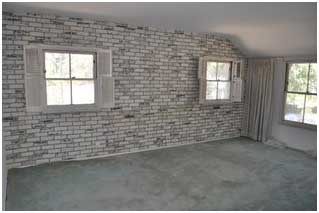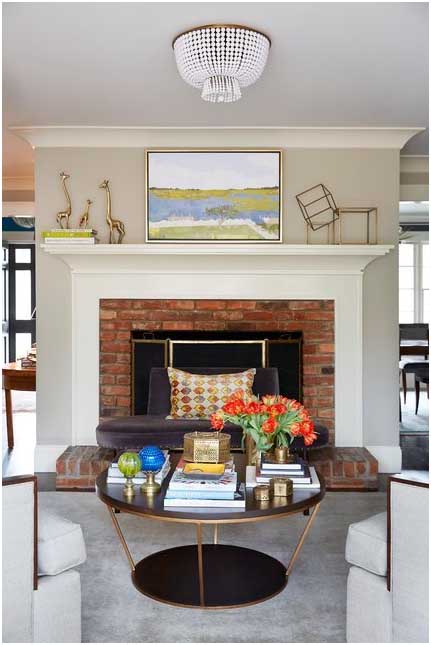Used as a selling point by real estate agents everywhere, an exposed brick wall — the more aged and weathered, the better — can add texture, character and a sense of history to a home.
But the kind of brick that came with my house in upstate New York was more akin to what you might see in a 1980s pizza chain than the coveted exposed brick found in so many prewar buildings in the city. Years of unattended leaks had left water stains across the top half of my brick fireplace, and below the mantel, it was a garish fire-engine red.
So when it was time to repaint the living room, I decided to give the fireplace a makeover, too. At about $55 for a gallon of Benjamin Moore’s Stonington Gray, the transformation was cheap, instant and effective. A $5 can of high-heat Rust-oleum in matte black applied to the brass fireplace screen finished off the new look.
But there are any number of ways to deal with an ugly brick wall. Contractors and interior designers shared some of their favorite fixes.
Continue reading the main story
Advertisement
Continue reading the main story
PAINT IT “If you are going to paint over an exposed-brick wall, opt for a neutral color such as white, black or gray,” said Andi Pepper, founder of Andi Pepper Interior Design, in New York. “The 1960s look” has seen a resurgence, she noted, “in painting brick walls white, as neutrals can really update the space.”
The “absolute worst decision,” she said, “would be to paint the brick wall a color.”
CLEAN AND VARNISH IT “There are two steps to this process to preserve the brick and the look correctly,” said Stephen B. Jacobs, who is Ms. Pepper’s husband and whose firm shares offices with hers. He used this technique in the couple’s Manhattan apartment, which has an exposed brick living room wall that extends out to a terrace. “The first thing to do is to use a wire brush to remove excess dirt, dust and any loose particles that may be on the surface. The second step is to apply several coats of a matte varnish.”
Do not, however, make the mistake of applying a high-gloss varnish to the wall, he cautioned: “A glossy finish destroys the whole look of the natural brick.”
CREATE A CUSTOM FINISH Emily Harris, a decorative artist in Cummings, Ga., who works with the online design service SwatchPop!, uses a light mortar wash and a variety of brushes, trowels and putty knives to transform unbecoming brick walls and fireplaces into something more weathered, textured and aesthetically pleasing.
When whitewashing brick, Ms. Harris recommended focusing on small sections, a bit at a time. “Step back, look at your work and decide where more needs to be added,” she said. “You can always add, but not as easily take away.”
She also suggested starting in an inconspicuous spot, to make sure you are using the right color, technique and materials: “I never start with the area that will be the main focal point.”
COVER IT WITH TILE When renovating the living room of a farmhouse in Buckhead, Ga., Bradley Odom, founder of the Atlanta design studio and store Dixon Rye, removed a layer of pink veined marble from the fireplace to uncover the original brick, only to discover it was beyond repair. “It was very dated and had some damage to it in the forms of a crack,” Mr. Odom said.
So he covered it with 12-inch-square limestone Crema Europa tile from Daltile (about $19 a square foot). Then he added a reclaimed cherry-wood beam for the mantel ($130 from Rare Woods and Veneers in Atlanta) and replaced the gas logs with concrete fireballs, a modern alternative to decorative logs (about $1,200). He had penny-spaced shiplap installed over the drywall above the mantel, and hung a carved wood-and-polychrome eagle ($1,000) that he found at a local antiques store to create a focal point, framed by a pair of Thomas O’Brien sconces from Visual Comfort ($350).
If you decide to go the tile route, Mr. Odom said, be sure to hire a mason to assess the brickwork before you start, to make sure it can be skimmed and covered evenly. “I would also advise having your designer draw up a sketch or rendering in advance to ensure you can visualize it,” he said. “There really is no going back once you do this.”

DEPLOY DRYWALL To give a modern look to a 1950s bedroom in the Hollywood Hills, Justin Krzyston of Stonehurst Construction in Los Angeles worked with Scott Joyce Design to replace old, mottled black-and-white bricks with drywall. “The drywall added a fresh, clean and bright new aesthetic,” he said.
Not all existing brick, of course, can be removed. “Some interior brick walls, such as the ones found in apartments, can’t be knocked down,” Mr. Krzyston said. In that case, he continued, “The best thing to do is to box up the wall with two-by-fours and add Sheetrock. You can then paint the Sheetrock with a fresh coat of paint, and your wall is an untouched canvas.”
And “it is much cheaper to put up a faux wall in front of the existing brick,” he pointed out, than “knocking down the brick completely.”

MA Allen, an interior designer in Raleigh, N.C., took this approach when she was renovating her own living room fireplace. After removing the mantel, the brass fire screen and the gas logs, she had the brick wall covered in drywall. Crown molding (about $4 a foot at ITC Millwork) was added to enhance the illusion of height in the room; a similar cove trim in a smaller profile was used on the mantel to tie the room together.
The brick hearth, which ran the length of the wall, was cut down at either end to align with the new mantel. The drywall was painted in Amazing Grayfrom Sherwin-Williams, in a satin finish; Benjamin Moore’s White Dove, in semigloss, was used on the trim. But “the existing brick was left intentionally exposed around the firebox and on the hearth for character and a sense of history,” she said. “By going over the brick with drywall, I was able to design a fireplace that would showcase just enough of the brick and allow the rest to blend in.”
Her advice if you’re doing it yourself? “Find a way to make the best of what it is that you have,” she said. And “keep it simple.”
MAKE IT A FEATURE Jaclyn Joslin of Coveted Home, a design and lifestyle store in Kansas City, Mo., turned an eyesore into a centerpiece by using cedar paneling to hide a patchy, exposed brick wall and an outdated closet door in her loft. Installed on a diagonal, the wood planks help to differentiate the living area from the bedroom behind. “The planks were sanded, and I had a water-based clear coat applied to keep the wood color as close to completely natural as possible,” Ms. Joslin said.
OBSCURE IT WITH ART “If you decide not to use any sort of paint, mortar or plaster products on your brick, oversized art is always a good idea,” said Ms. Harris, the decorative artist. “A gallery wall or collection of art can be a great way to divert attention from the ugly brick.”
In a guesthouse in Dallas, Carter Kay of Carter Kay Interiors, in Atlanta, installed custom iron rods to display a movable art collection against the exposed brick walls.
“We thought of it as a textured neutral,” Ms. Kay said of the brick backdrop, which was balanced by upholstered furniture. “We played up the softer corduroys, linens and cottons for comfort.”



















Your Message